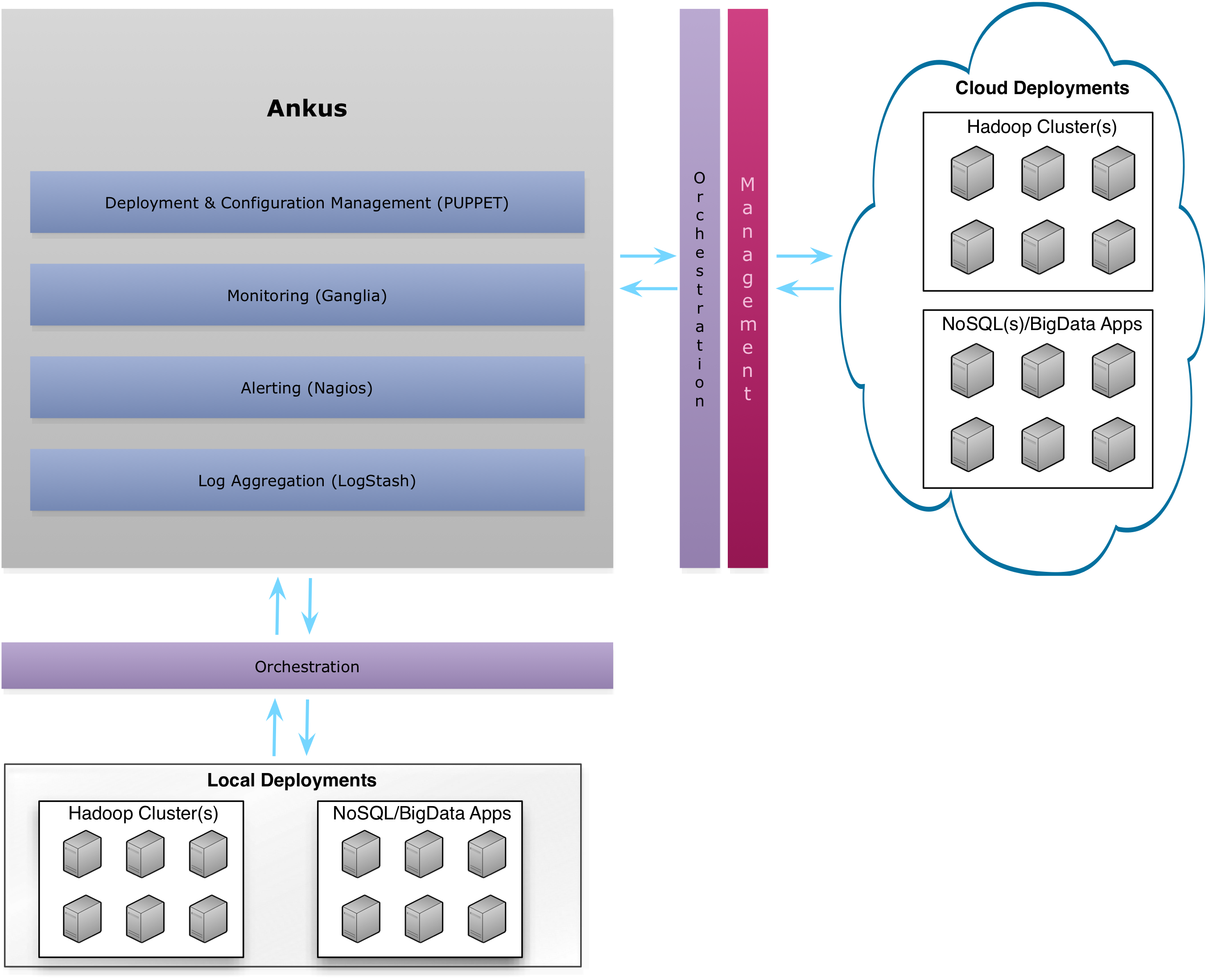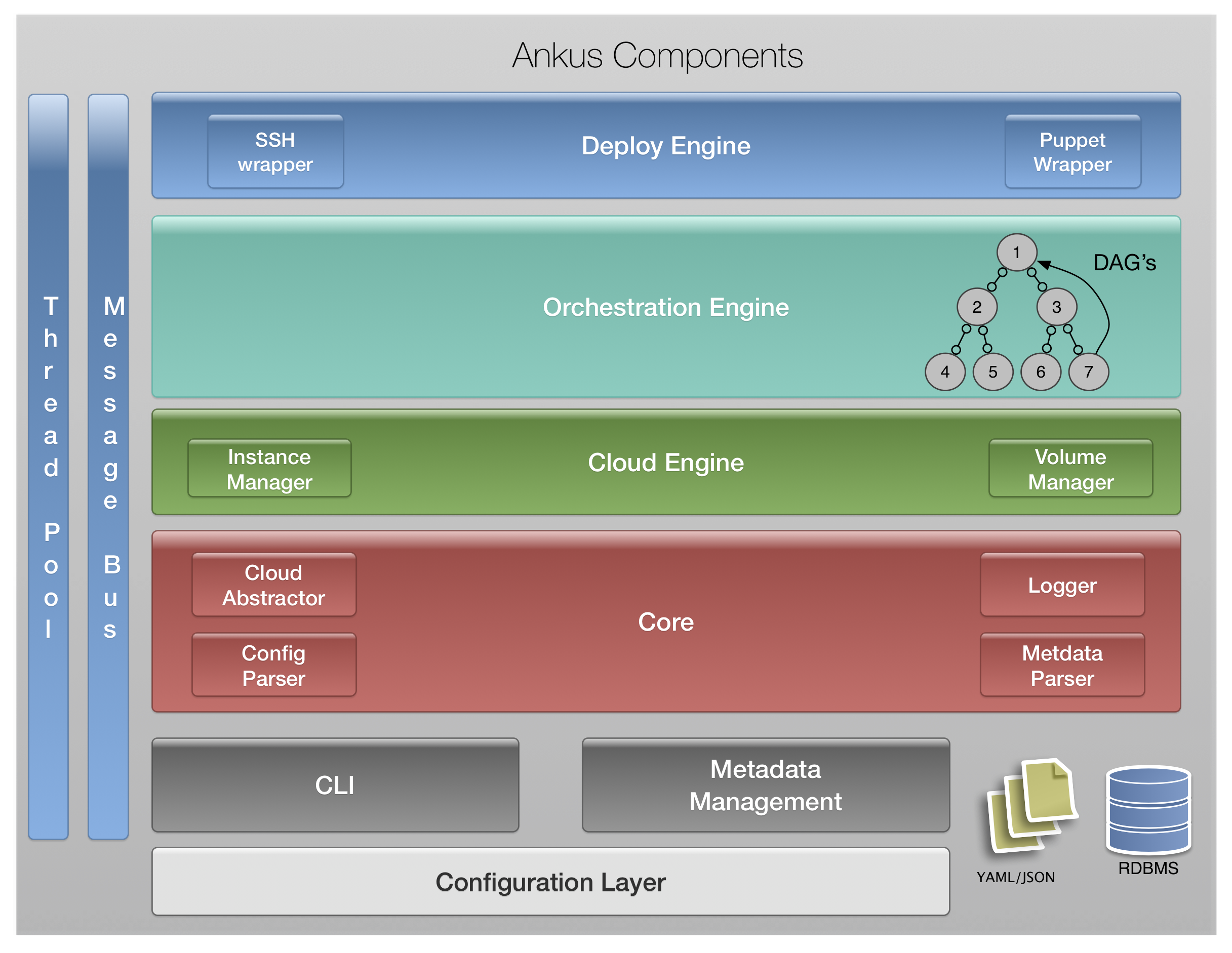Ankus
Ankus is a big-data deployment & orchestration tool. Handles the installation & management of:
- hadoop (hadoop-2.0.0)
- hadoop ecosystem tools: pig (0.11.x), hive (0.10.x), sqoop2, oozie (3.3.x), hadoop-search
- hbase (hbase-0.94)
- cassandra (cassandra-2.0.x)
- kafka (kafka-0.8)
- storm (storm-0.8.2)
Ankus can handle deployments in local (group of local machines) as well as cloud (servers hosted by cloud providers).
- Local mode - User can specify instance roles, supported operating systems (
centosorubuntu) for deployments. - Cloud mode - Ankus will create/manage instances and auto assigns roles to them. Currently ankus supports AWS(Amazon Web Services), RackSpace & OpenStack.
Ankus leverages several open source tools such as:
- puppet & puppetdb for deployment and configuration management
- passenger for scaling the deployments
- ganglia for monitoring
- nagios for alerting
- logstash for log aggregation
Supported Deployment Types:
- Highly Available Hadoop & HBase cluster deployments
- Secure Hadoop & HBase cluster deployments (using kerberos)
- Cassandra, Storm & Kafka deployments
###Ankus Architecture
###Ankus Internal Components
Installation
###Dependencies
To install ruby 1.9.3 and other dependencies on supported platforms follow these instructions:
-
CentOS:
yum -y install git gcc ruby-devel libxml2 libxml2-devel libxslt libxslt-devel make curl curl -L get.rvm.io | bash -s stable source /etc/profile.d/rvm.sh source ~/.rvm/scripts/rvm || source /usr/local/rvm/scripts/rvm rvm requirements --verify-downloads 1 rvm install 1.9.3 rvm use 1.9.3 --default rvm rubygems current
-
Ubuntu:
apt-get install -y build-essential libxml2-dev libxslt1-dev libreadline-dev zlib1g-dev git curl curl -L get.rvm.io | bash -s stable source /etc/profile.d/rvm.sh source ~/.rvm/scripts/rvm || source /usr/local/rvm/scripts/rvm rvm requirements --verify-downloads 1 rvm install 1.9.3 rvm use 1.9.3 --default rvm rubygems current
-
Mac OSX:
Requirements:
-
Download and install XCode Command Line Tools (using any of the following ways)
- from apple developer console and logging using developer account
- from Github
- for OSX Mavericks you can use
xcode-select --installcommand from terminal to install command line tools
-
Install Homebrew
ruby -e "$(curl -fsSL https://raw.github.com/Homebrew/homebrew/go/install)"
Install dependencies for mac osx:
brew install libxml2 libxslt brew link libxml2 libxslt curl -L get.rvm.io | bash -s stable source ~/.rvm/scripts/rvm || source /usr/local/rvm/scripts/rvm rvm requirements --verify-downloads 1 rvm install 1.9.3 rvm use 1.9.3 --default rvm rubygems current
-
NOTE: Ankus requires ruby version >= 1.9.2.
###Installing Ankus
Two ways to install Ankus:
-
Installing Ankus from Source:
cd ~ && git clone https://github.com/ashrithr/ankus.git gem install bundle --no-ri --no-rdoc cd ankus && bundle install
OR
-
Packaging and installing Ankus as a ruby gem:
cd ~ && git clone https://github.com/ashrithr/ankus.git cd ankus && git checkout improvements gem build ankus.gemspec && gem install ankus-*.gem
Usage:
###Deployment in Cloud (AWS | Rackspace | Openstack):
To quickly deploy big-data clusters like hadoop, hbase, cassandra, storm or kafka in the cloud, follow these steps:
NOTE: All the paths specified so-forth are relative to where ankus is installed
Ankus is a configuration based deployment platform, so deployments should be specified as files written in YAML. The example configurations provided in conf directory for several sample deployment(s) which can be used as baseline templates and are fairly explanatory with deployment scenarios illustrated.
-
Modify the configuration in (conf directory of where you installed ankus), for convenience ankus comes with pre-built configurations for aws, rackspace and local install modes.
-
If you are working with aws use
conf/ankus_conf_cloud_aws_example.yamlas a base line template for configurationcp conf/exmaple_confs/ankus_conf_cloud_aws_example.yaml conf/ankus_conf.yaml
-
If you are working with rackspace cloud platform use
conf/ankus_conf_cloud_rs_example.yamlas a base line template for configurationcp conf/exmaple_confs/ankus_conf_cloud_rs_example.yaml conf/ankus_conf.yaml
-
If you are working with openstack cloud platform use
conf/ankus_conf_cloud_openstack_example.yamlas a base line template for configurationcp conf/exmaple_confs/ankus_conf_cloud_openstack_example.yaml conf/ankus_conf.yaml
-
-
Once base line configuration file is in place you can edit the configuration file (
conf/ankus_conf.yaml) in your favorite text editor, the configuration itself is elaborated with comments in place for every option in the config file. Modify according to your deployment scenario(s). -
Once all the values required are filled you can check to see if the config looks ok by running the following command
bin/ankus parse
which will parse the configuration file (by default conf/ankus_conf.yaml) and show if there are any warnings or errors. If you have saved the configuraion file with different name or placed the configuration file in another location you can explicitly pass the config as
bin/ankus parse --config conf/ankus.yaml
-
Now, you are all set to deploy a cluster using the following command
bin/ankus deploy
Which will deploy cluster as specified in the configuration, deployment includes creating instances in the cloud along with creating/mounting volumes and installing/configuring respective roles. This might take around 30-45 mins for the deployment to complete based on the type of deployment.
Once the deployment is complete, ankus will show the overview of cluster
-
Once deployment is complete you can see the cluster information using the following command
bin/ankus info --extended
extendedflag will show you more information related to the deployment such as URL(s) for accessing the important daemons and also all the nodes in the deployment and their roles. -
Once you have a running cluster, if you need more worker nodes to do additional tasks (or) store more data just edit the configuration file and then run the following command
bin/ankus deploy --reload
Say for example you want 2 more slave_nodes (hadoop worker nodes) then change the respective configuration param in the config file in this case the config param is
slave_nodesand increase the count to 2 and running the above command will provision 2 vm's in cloud and configure vm's and automatically refreshes the cluster. -
Similarly, if you want to change any configuration properties related to hadoop, you can simply edit
conf/ankus_hadoop_conf.yamlwhich contains basic hadoop configurations (or)conf/ankus_hbase_conf.yamlwhich contains hbase related properties (or)conf/ankus_cassandra_conf.yamlcontains cassandra related properties, once edited you can runbin/ankus refresh
which will automatically refresh the nodes with updated configurations and will restart the respective daemons
-
Ankus automatically stores the roles of the machines being provisioned and automatically do
sshinto instances using their roles like this:bin/ankus ssh --role controller
which will create a ssh tunnel into controller, similarly for hadoop namenode:
bin/ankus ssh --role namenode
-
Also, down the line once you have completed your work with cluster in the cloud, you can tell ankus to destroy the cluster using
bin/ankus destroy
this is only applicable to only cloud deployments
###Deployment in Local:
Local deployment mode, is where user provides the instances on which specified roles are managed.
Note: Passwordless-ssh should be setup between host (from which you are running ankus) to all the hosts involved in deployment as well as to the controller itself
Similar to that of cloud deployments, local deployment also has template configuration file that could be used as base line
cp conf/example_confs/ankus_conf_local_example.yaml conf/ankus_conf.yamlModify the configuration file as per the requirements and then
-
To deploy a cluster
bin/ankus deploy
-
To add more worker hosts to an existing cluster, edit the configuration file and add more nodes to respective config params and run
bin/ankus deploy --reload
-
Refresh configuration files
bin/ankus refresh
-
SSH into a instance
bin/ankus ssh --role controller
-
Retrieve information about the cluster
bin/ankus info
##Future Work (WIP)
More deployment modules are in development:
##Author: Ashrith
##License:
Apache 2.0. Please see LICENSE.txt. All contents copyright (c) 2013, Cloudwick Labs.

